NASA’s New Horizons probe has beamed back new detailed images of Pluto’s surface, revealing icy and mountainous regions.
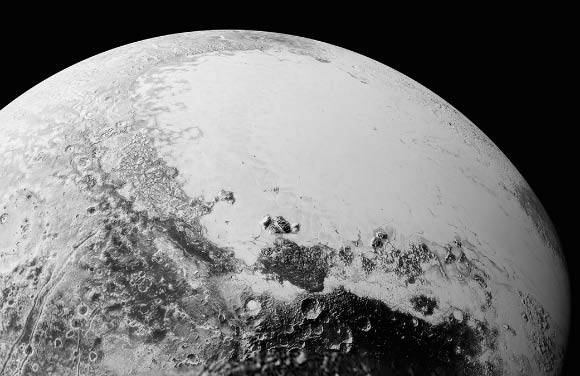
This view of Pluto, based on the latest images to be downlinked from NASA’s New Horizons spacecraft, shows what you would see if you were approximately 1,100 miles (1,800 km) above Pluto’s equatorial area, looking northeast over the dark, cratered, named Cthulhu Regio toward the bright, smooth, expanse of icy plains called Sputnik Planum. The entire expanse of terrain seen in this image is 1,100 miles (1,800 km) across. Image credit: NASA / Johns Hopkins University Applied Physics Laboratory / Southwest Research Institute.
These images were taken as New Horizons flew past Pluto on July 14, 2015, from a distance of 50,000 miles (80,000 km).
“The surface of Pluto is every bit as complex as that of Mars. The randomly jumbled mountains might be huge blocks of hard water ice floating within a vast, denser, softer deposit of frozen nitrogen within the region informally named Sputnik Planum,” said Dr Jeff Moore of NASA’s Ames Research Center, who is the leader of the New Horizons Geology, Geophysics and Imaging team.
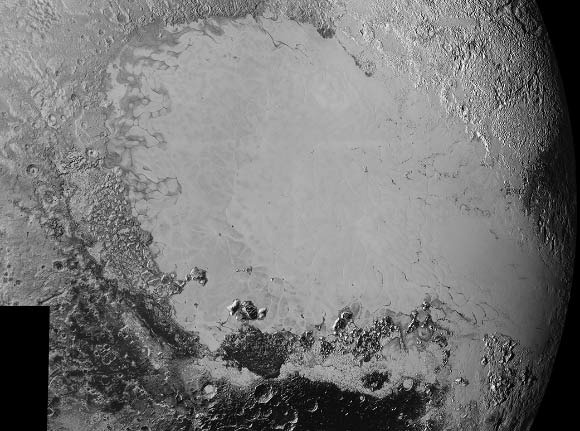
This mosaic is dominated by the icy plain Sputnik Planum, the smooth, bright region across the center. The image also features a tremendous variety of other landscapes surrounding the region. The smallest visible features are 0.5 miles (0.8 km) in size, and the mosaic covers a region roughly 1,000 miles (1600 km) wide. Image credit: NASA / Johns Hopkins University Applied Physics Laboratory / Southwest Research Institute.
“This is what we came for – these images, spectra and other data types that are going to help us understand the origin and the evolution of the Pluto system for the first time,” said Dr Alan Stern of the Southwest Research Institute, principal investigator for New Horizons.
“And what’s coming is not just the remaining 95% of the data that’s still aboard the spacecraft – it’s the best datasets, the highest-resolution images and spectra, the most important atmospheric datasets, and more. It’s a treasure trove.”
The new images reveal features as diverse as possible dunes, nitrogen ice flows that apparently oozed out of mountainous regions onto plains, and even networks of valleys that may have been carved by material flowing over the surface of the dwarf planet.
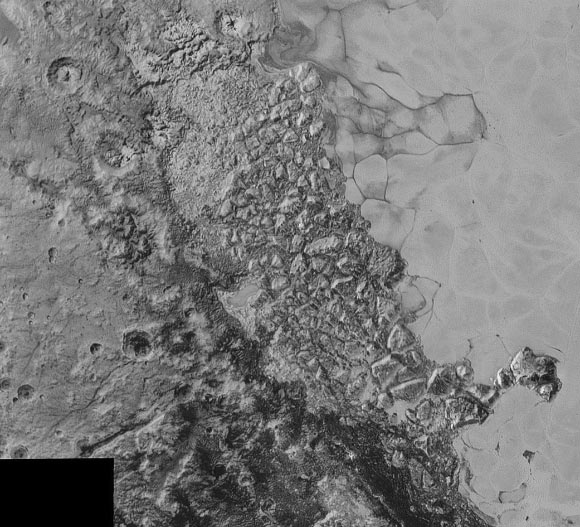
In the center of this 300-mile (470-km) wide image of Pluto is a large region of jumbled, broken terrain on the northwestern edge of Sputnik Planum. Image credit: NASA / Johns Hopkins University Applied Physics Laboratory / Southwest Research Institute.
They also show large regions that display chaotically jumbled mountains reminiscent of disrupted terrains on Europa, one of Jupiter’s moons.
“Pluto is showing us a diversity of landforms and complexity of processes that rival anything we’ve seen in the Solar System,” Dr Stern said.
“If an artist had painted this Pluto before our flyby, I probably would have called it over the top – but that’s what is actually there.”
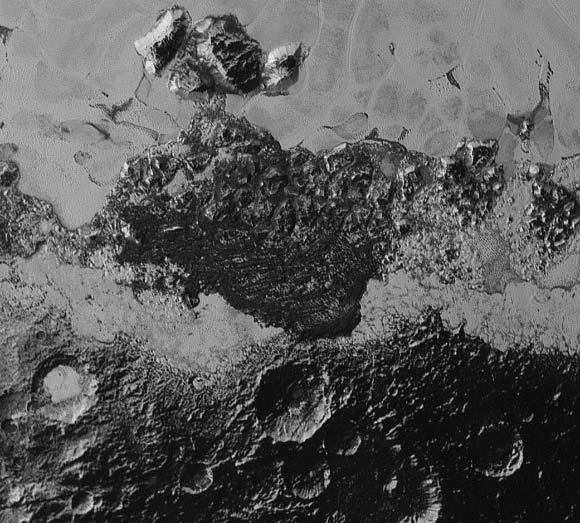
This 220-mile (350-km) wide image of Pluto shows the incredible diversity of surface reflectivities and geological landforms on the dwarf planet. The image includes dark, ancient heavily cratered terrain; bright, smooth geologically young terrain; assembled masses of mountains; and an enigmatic field of dark, aligned ridges that resemble dunes; its origin is under debate. Image credit: NASA / Johns Hopkins University Applied Physics Laboratory / Southwest Research Institute.
The images also show the most heavily cratered – and thus oldest – terrain yet seen on Pluto next to the youngest, most crater-free icy plains.
There might even be a field of dark wind-blown dunes, among other possibilities.
“Seeing dunes on Pluto – if that is what they are – would be completely wild, because Pluto’s atmosphere today is so thin. Either Pluto had a thicker atmosphere in the past, or some process we haven’t figured out is at work. It’s a head-scratcher,” said Dr William McKinnon of Washington University, St. Louis.
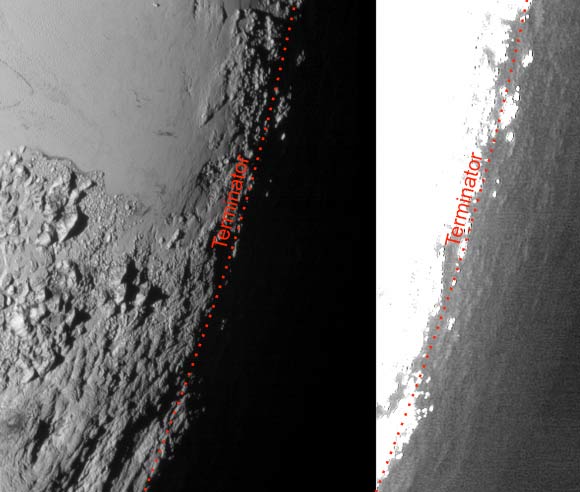
This image of Pluto, processed in two ways, shows how Pluto’s bright, high-altitude atmospheric haze produces a twilight that softly illuminates the surface before sunrise and after sunset, allowing the sensitive cameras on New Horizons to see details in nighttime regions that would otherwise be invisible. The right-hand version of the image has been greatly brightened to bring out faint details of rugged haze-lit topography beyond Pluto’s terminator, which is the line separating day and night. Image credit: NASA / Johns Hopkins University Applied Physics Laboratory / Southwest Research Institute.
New Horizons is now 3.06 billion miles (4.92 billion km) from our planet, and 43.7 million miles (70.3 million km) beyond Pluto. The probe is healthy and all systems are operating normally.







